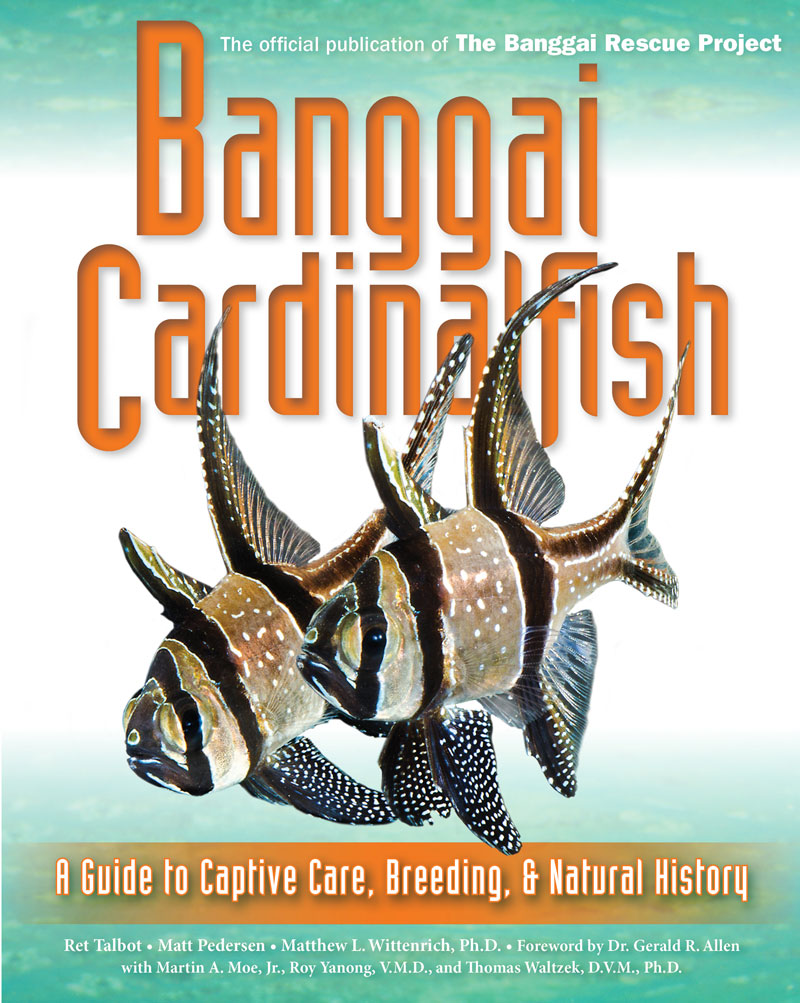For any of our readers who have been following the Banggai Rescue Project, we have some great news — the long-awaited book from the Banggai Rescue Project is finally launching at MACNA this week in Florida.
The new book titled Banggai Cardinalfish: A Guide to Captive Care, Breeding & Natural History, is a collaboration between some of the best and brightest we have in our awesome hobby including: Ret Talbot, Matt Pedersen, Matthew L. Wittenrich, Ph.D., Martin A. Moe, Jr., Roy Yanong, V.M.D. and Thomas Waltzek, D.V.M., Ph.D.
The quirky fish has founds its way into our hearts since being introduced in 1994, however there is a significant drain on the natural habitat for the Banggai cardinalfish. This Banggai’s home is a small area and research is showing that they are being threatened by over collection and other factors. The team is hoping this book will help shine more light on the fish and as hobbyists, what we can do to keep the fish thriving in its natural habitat.
If you are at MACNA 2013, make sure to stop by and get your copy of this incredible book. If you won’t be attending, you can purchase the book online. The official press release follows.
BANGGAI CARDINALFISH BOOK TO DEBUT AT MACNA SOUTH FLORIDA
HOLLYWOOD, FLORIDA – The long-awaited book from the Banggai Rescue Project will be launched at the Marine Aquarium Conference of North America here, August 30 to September 1.
Entitled Banggai Cardinalfish: A Guide to Captive Care, Breeding & Natural History, the book is authored by a who’s who in the marine aquarium world: Ret Talbot, Matt Pedersen, Matthew L. Wittenrich, Ph.D., Martin A. Moe, Jr. and aquatic veterianarians Roy Yanong, V.M.D. and Thomas Waltzek, D.V.M., Ph.D. The foreword is written by Dr. Gerald Allen, who rediscovered the species and presented it to the aquarium world in 1994. James Lawrence, editor of CORAL Magazine and more than 30 Microcosm marine aquarium titles, wrote the introduction and edited the volume. Julian Sprung, through his Two Little Fishies Inc., is the exclusive distributor of the book.
“Our goals in launching the Banggai Rescues Project and producing this book were threefold,” says Lawrence:
- Provide the marine aquarium world with a fresh, unbiased perspective on the trade in wild-caught Banggai Cardinalfish.
- Encourage more local captive breeding of the species by hobbyists in developed countries to help relieve some of the pressure of collection from wild stocks.
- Start a scientific investigation of the Banggai Cardinalfish Iridovirus (BCIV), a disease of recently imported wild Pterapogon kauderni that is terrifyingly efficient in killing entire shipments of fish and effectively stymying commercial aquaculture efforts.
Inside the Banggai Triangle
Starting with Allen’s recounting of his discovery of Pterapogon kauderni in a remote archipelago in Sulawesi, Indonesia, the book follows a 2012 expedition to the so-called Banggai Triangle. Embedded photojournalist Ret Talbot provides a first-hand view of the species in its native waters and as studied by a team of American and Indonesia marine scientists.
What they found were areas that once supported massive swarms of Banggai Cardinalfish are now fished out or showing obvious signs of over-collection.
Says Lawrence: “Some in the aquarium trade and media have suggested that we were crying wolf in even suggesting that this species is in trouble from over-collection. It was not our role to go to Indonesia and do population studies, but rather to join forces with LINI and the scientists there who are on the ground and in the waters of the Banggai Islands. They have been counting fish, monitoring exports, and tracking the decline of this fish in its endemic range, and, as Ret Talbot reports the news is not good.”
“This initiative [to protect the species] is becoming increasingly urgent as the wild populations of Banggai Cardinalfish are being depleted day by day,” states Gayatri Gayatri Reksodihardjo-Lilley, head of the Indonesia Nature Federation, which is working with local fishermen to make marine livestock collection more sustainable. The problem, she says, “is mainly due to over-collection to supply the marine ornamental trade.
“The recent inclusion of the Banggai Cardinalfish on the IUCN List of endangered species has had no positive effect on levels of exploitation. Besides over-collection, there are many other factors affecting the area, which can only be addressed by implementing a management plan for the archipelago.”
Lawrence says that the Banggai Rescue team hopes that the book will make more people in the marine aquarium world aware of the real situation and foster more cooperation between the livestock trade and those working to reform collection and handling in the source country. The deadly Banggai Cardinalfish Iridovirus, he says, remains a mystery and is something worthy of further research in the years ahead.
What Hobbyists Can Do
The book also devotes a considerable portion of its 304 pages to hands-on husbandry and breeding advice for marine aquarists wanting to keep Banggai Cardinalfish and perhaps produce them to supply local demands for captive-bred fish.
Matt Pedersen, who established a Banggai breeding section in his Minnesota basement fishroom, dispels the claim that breeding Pterapogon kauderni is akin to raising Guppies.
Pedersen writes: “In 2009, Daniel Knop put forth a perplexing assertion: This species is the easiest to breed. Tank-bred Pterapogon kauderni ought to be veritably pouring from private hands into the trade. But, as colleagues in the retail aquarium-hobby have recently confirmed, P. kauderni are not widely available as tank-breds.” Knop is the founding editor of KORALLE, the German parent magazine of CORAL, and an experienced keeper and home breeder of the Banggai Cardinalfish.



